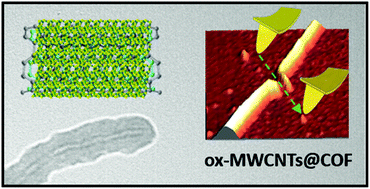Multifunctional carbon nanotubes covalently coated with imine-based covalent organic frameworks: exploring structure–property relationships through nanomechanics†
Abstract
The assembly of 3-dimensional covalent organic frameworks on the surface of carbon nanotubes is designed and successfully developed for the first time via the hybridization of imine-based covalent organic frameworks (COF-300) and oxidized MWCNTs by one-pot chemical synthesis. The resulting hybrid material ox-MWCNTs@COF exhibits a conformal structure that consists of a uniform amorphous COF layer covering the ox-MWCNT surface. The measurements of individual hybrid nanotube mechanical strength performed with atomic force microscopy provide insights into their stability and resistance. The results evidence a very robust hybrid tubular nanostructure that preserves the benefits obtained from COF, such as CO2 adsorption. Further digestion of the organic structure with aniline enables the study of the interplay between the hybrid interface and its nanomechanics. This new hybrid nanomaterial presents exceptional mechanical and electrical properties, merging the properties of the CNT template and COF-300.



 Please wait while we load your content...
Please wait while we load your content...